2001 MERCEDES-BENZ E430 Start engine
[x] Cancel search: Start enginePage 260 of 341
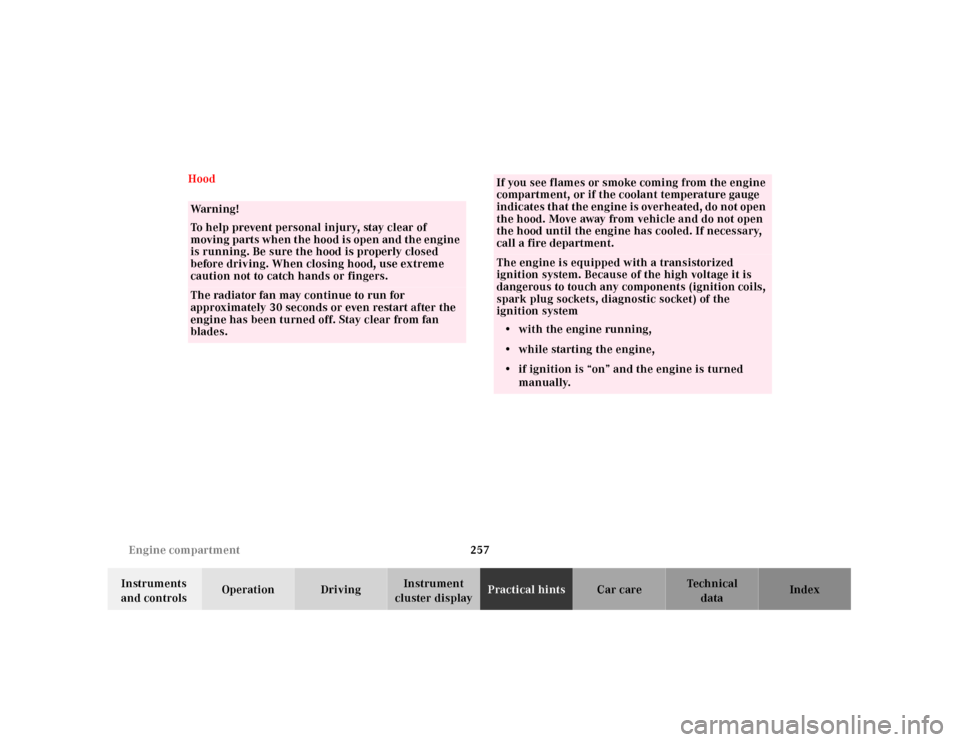
257 Engine compartment
Technical
data Instruments
and controlsOperation DrivingInstrument
cluster displayPractical hintsCar care Index Hood
Wa r n i n g !
To help prevent personal injury, stay clear of
moving parts wh en t he hood is open and th e engine
is running. Be sure the hood is properly closed
before driving. When closing hood, use extreme
caution not to catch hands or fingers.The radiator fan may continue to run for
approximately 30 seconds or even restart after the
engine has been turned off. Stay clear from fan
blades.
If you see flames or smoke coming from the engine
compartment, or if the coolant temperature gauge
indicates that the engine is overheated, do not open
the hood. Move away from vehicle and do not open
the hood until the engine has cooled. If necessary,
call a fire department.The engine is equipped with a transistorized
ignition system. Because of the high voltage it is
dangerous to touch any components (ignition coils,
spark plug sockets, diagnostic socket) of the
ignition system
• with the engine running,
• while starting the engine,
• if ignition is “on” and the engine is turned
manually.
Page 276 of 341
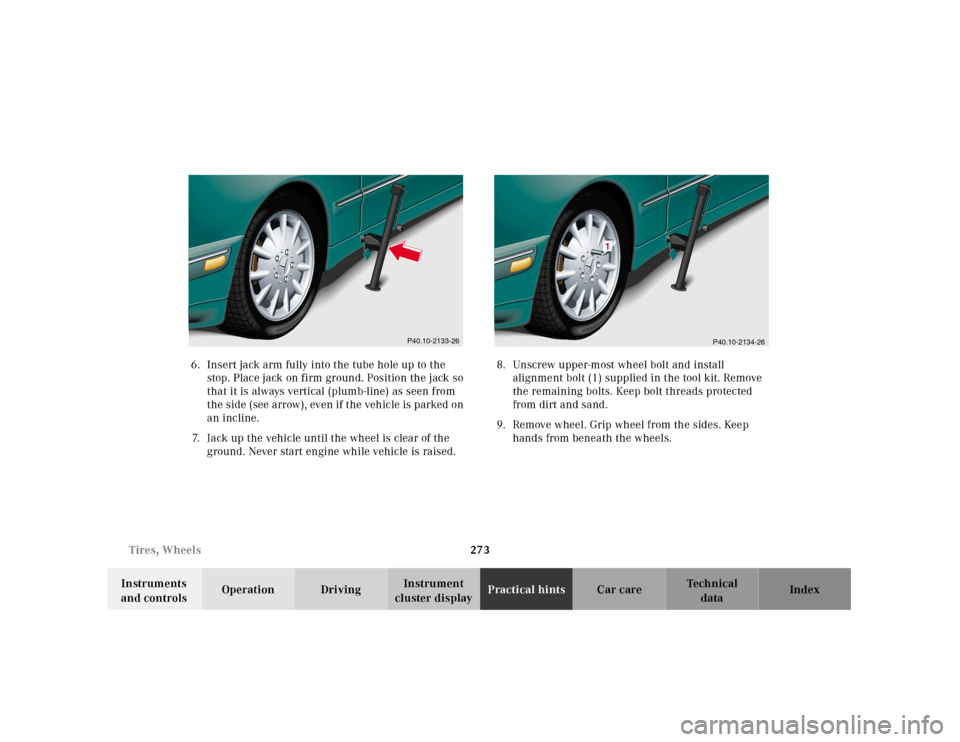
273 Tires, Wheels
Technical
data Instruments
and controlsOperation DrivingInstrument
cluster displayPractical hintsCar care Index 6. Insert jack arm fully into the tube hole up to the
stop. Place jack on firm ground. Position the jack so
that it is always vertical (plumb-line) as seen from
the side (see arrow), even if the vehicle is parked on
an incline.
7. Jack up the vehicle until the wheel is clear of the
ground. Never start engine while vehicle is raised.8. Unscrew upper-most wheel bolt and install
alignment bolt (1) supplied in the tool kit. Remove
the remaining bolts. Keep bolt threads protected
from dirt and sand.
9. Remove wheel. Grip wheel from the sides. Keep
hands from beneath the wheels.
P40.10-2133-26
P40.10-2134-26
1
Page 283 of 341
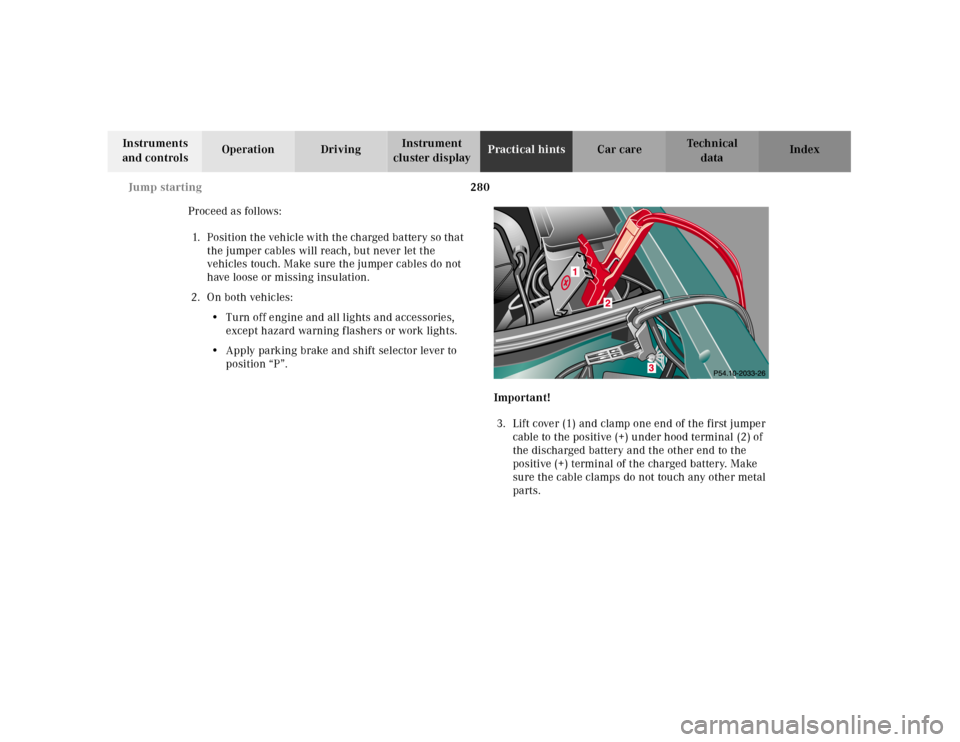
280 Jump starting
Technical
data Instruments
and controlsOperation DrivingInstrument
cluster displayPractical hintsCar care Index
Proceed as follows:
1. Position the vehicle with the charged battery so that
the jumper cables will reach, but never let the
vehicles touch. Make sure the jumper cables do not
have loose or missing insulation.
2. On both vehicles:
•Turn off engine and all lights and accessories,
except hazard warning flashers or work lights.
•Apply parking brake and shift selector lever to
position “P”.
Important!
3. Lift cover (1) and clamp one end of the first jumper
cable to the positive (+) under hood terminal (2) of
the discharged battery and the other end to the
positive (+) terminal of the charged battery. Make
sure the cable clamps do not touch any other metal
parts.
Page 284 of 341
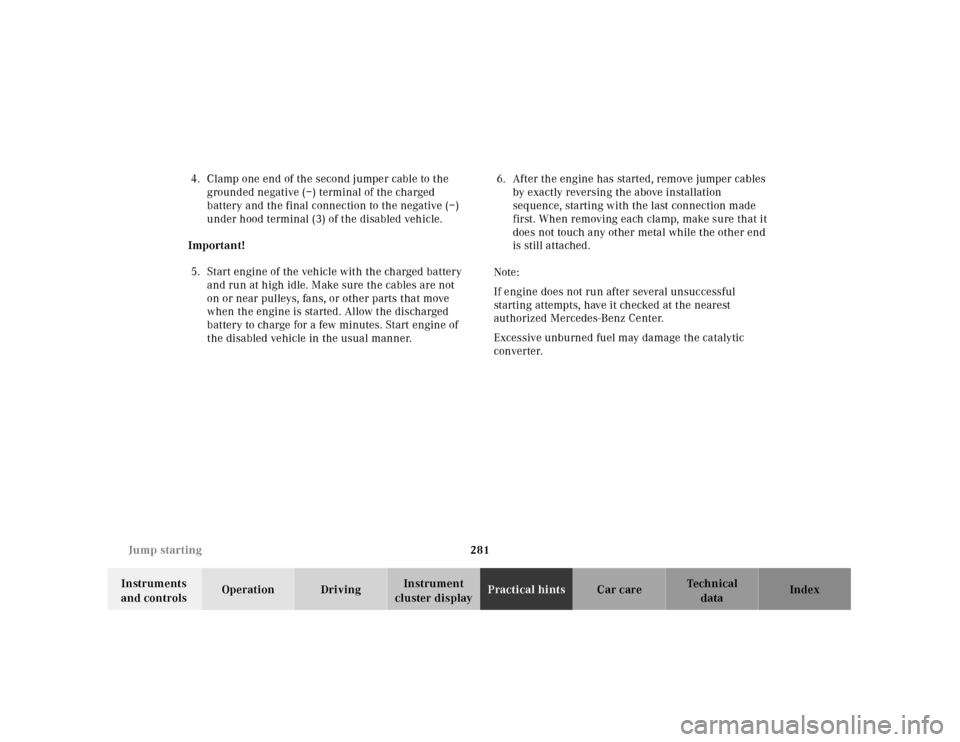
281 Jump starting
Technical
data Instruments
and controlsOperation DrivingInstrument
cluster displayPractical hintsCar care Index 4. Clamp one end of the second jumper cable to the
grounded negative (–) terminal of the charged
battery and the final connection to the negative (–)
under hood terminal (3) of the disabled vehicle.
Important!
5. Start engine of the vehicle with the charged battery
and run at high idle. Make sure the cables are not
on or near pulleys, fans, or other parts that move
when the engine is started. Allow the discharged
battery to charge for a few minutes. Start engine of
the disabled vehicle in the usual manner.6. After the engine has started, remove jumper cables
by exactly reversing the above installation
sequence, starting with the last connection made
first. When removing each clamp, make sure that it
does not touch any other metal while the other end
is still attached.
Note:
If engine does not run after several unsuccessful
starting attempts, have it checked at the nearest
authorized Mercedes-Benz Center.
Excessive unburned fuel may damage the catalytic
converter.
Page 296 of 341
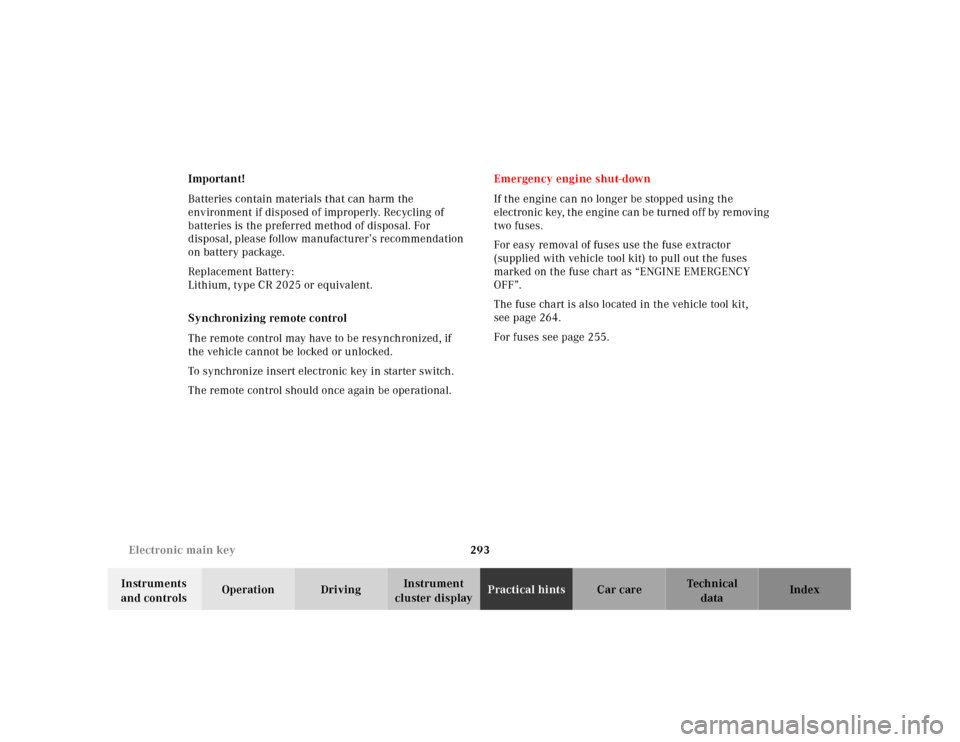
293 Electronic main key
Technical
data Instruments
and controlsOperation DrivingInstrument
cluster displayPractical hintsCar care Index Important!
Batteries contain materials that can harm the
environment if disposed of improperly. Recycling of
batteries is the preferred method of disposal. For
disposal, please follow manufacturer’s recommendation
on battery package.
Replacement Battery:
Lithium, type CR 2025 or equivalent.
Synchronizing remote control
The remote control may have to be resynchronized, if
the vehicle cannot be locked or unlocked.
To synchronize insert electronic key in starter switch.
The remote control should once again be operational.Emergency engine shut-down
If the engine can no longer be stopped using the
electronic key, the engine can be turned off by removing
two fuses.
For easy removal of fuses use the fuse extractor
(supplied with vehicle tool kit) to pull out the fuses
marked on the fuse chart as “ENGINE EMERGENCY
OFF”.
The fuse chart is also located in the vehicle tool kit,
seepage264.
For fuses see page 255.
Page 326 of 341
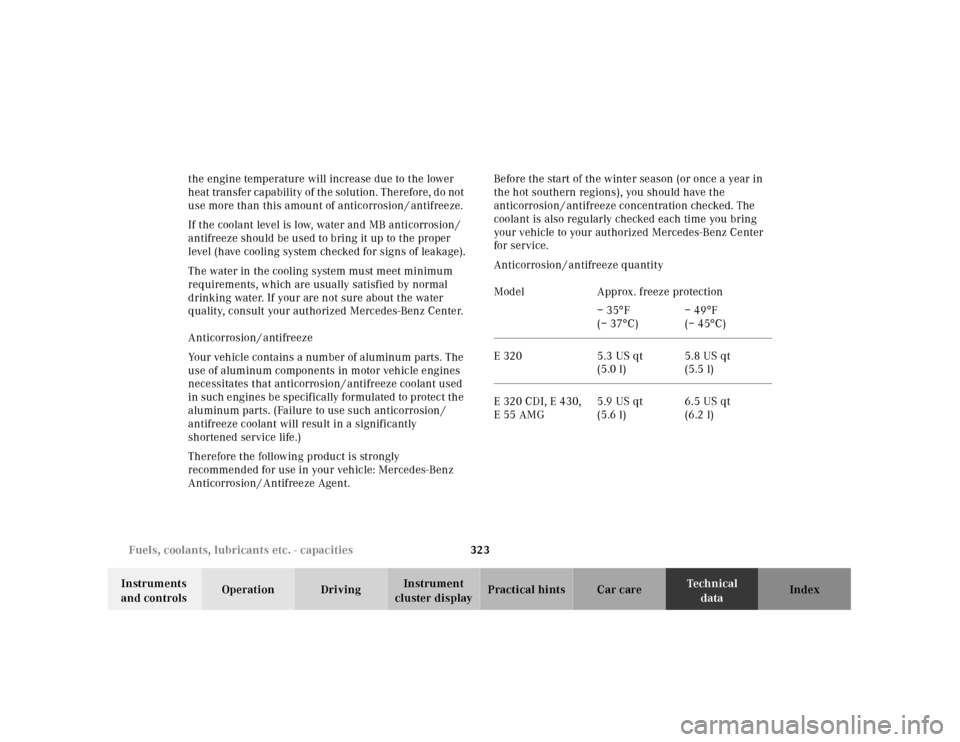
323 Fuels, coolants, lubricants etc. - capacities
Technical
data Instruments
and controlsOperation DrivingInstrument
cluster displayPractical hints Car care Index the engine temperature will increase due to the lower
h eat transfer ca pa bil ity of th e sol ution. Therefore, d o not
use more than this amount of anticorrosion / antifreeze.
If the coolant level is low, water and MB anticorrosion /
antifreeze should be used to bring it up to the proper
level (have cooling system checked for signs of leakage).
The water in the cooling system must meet minimum
requirements, which are usually satisfied by normal
drinking water. If your are not sure about the water
quality, consult your authorized Mercedes-Benz Center.
Anticorrosion / antifreeze
Your vehicle contains a number of aluminum parts. The
use of aluminum components in motor vehicle engines
necessitates that anticorrosion / antifreeze coolant used
in such e ng ines b e specif ica lly formul ated to protec t th e
aluminum parts. (Failure to use such anticorrosion /
antifreeze coolant will result in a significantly
shortened service life.)
Therefore the following product is strongly
recommended for use in your vehicle: Mercedes-Benz
Anticorrosion / Antifreeze Agent.Before the start of the winter season (or once a year in
the hot southern regions), you should have the
anticorrosion / antifreeze concentration checked. The
coolant is also regularly checked each time you bring
your vehicle to your authorized Mercedes-Benz Center
for service.
Anticorrosion / antifreeze quantity
Model Approx. freeze protection
– 35°F
(– 37°C)– 49°F
(– 45°C)
E 320 5.3 US qt
(5.0 l)5.8 US qt
(5.5 l)
E 320 CDI, E 430,
E 55 AMG5.9 US qt
(5.6 l)6.5 US qt
(6.2 l)
Page 337 of 341
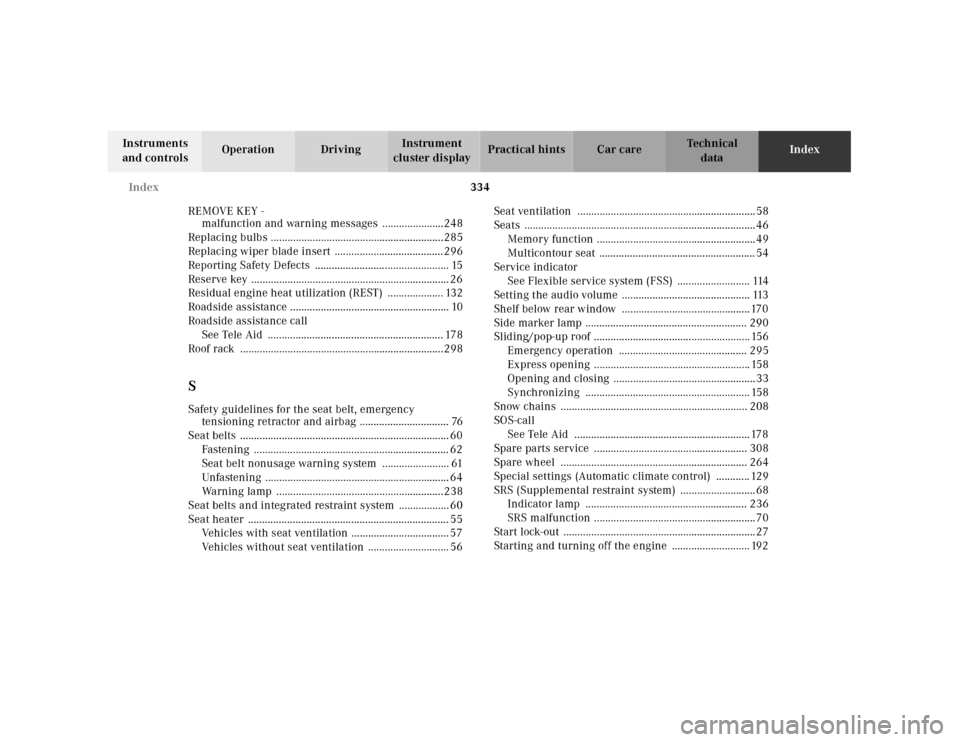
334 Index
Technical
data Instruments
and controlsOperation DrivingInstrument
cluster displayPractical hints Car careIndex
REMOVE KEY -
malfunction and warning messages ......................248
Replacing bulbs ..............................................................285
Replacing wiper blade insert .......................................296
Reporting Safety Defects ................................................ 15
Reserve key ....................................................................... 26
Residual engine heat utilization (REST) .................... 132
Roadside assistance ......................................................... 10
Roadside assistance call
See Tele Aid ............................................................... 178
Roof rack .........................................................................298
SSafety guidelines for the seat belt, emergency
tensioning retractor and airbag ................................ 76
Seat belts ........................................................................... 60
Fastening ...................................................................... 62
Seat belt nonusage warning system ........................ 61
Unfastening .................................................................. 64
Warning lamp ............................................................238
Seat belts and integrated restraint system .................. 60
Seat heater ........................................................................ 55
Vehicles with seat ventilation ................................... 57
Vehicles without seat ventilation ............................. 56Seat ventilation ................................................................58
Seats ...................................................................................46
Memory function .........................................................49
Multicontour seat ........................................................ 54
Service indicator
See Flexible service system (FSS) .......................... 114
Setting the audio volume .............................................. 113
Shelf below rear window ..............................................170
Side marker lamp .......................................................... 290
Sliding/pop-up roof ........................................................ 156
Emergency operation .............................................. 295
Express opening ........................................................ 158
Opening and closing ...................................................33
Synchronizing ........................................................... 158
Snow chains ................................................................... 208
SOS-call
See Tele Aid ...............................................................178
Spare parts service ....................................................... 308
Spare wheel ................................................................... 264
Special settings (Automatic climate control) ............ 129
SRS (Supplemental restraint system) ...........................68
Indicator lamp .......................................................... 236
SRS malfunction ..........................................................70
Start lock-out .....................................................................27
Starting and turning off the engine ............................ 192